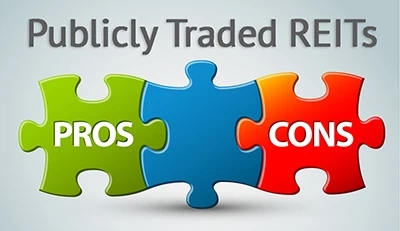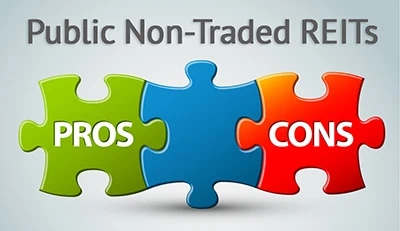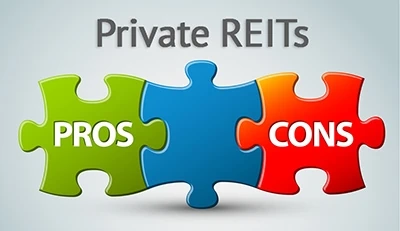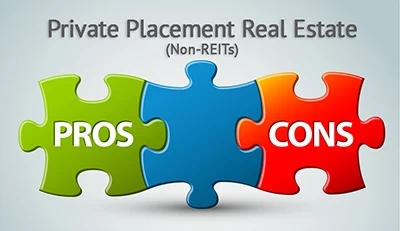Anyone who’s ever played Monopoly might guess that real estate can be an excellent investment option—and they’d be right. Real estate can provide a steady cash flow as it diversifies your portfolio.
However, few people have the capital and expertise to actually acquire, manage, improve, and resell expensive properties.
Fortunately, through real estate investment trusts (REITs) and private placements, investors can own slivers of high-end real estate.
Several significant differences separate publicly traded REITs from private placements. Investors need to know how they differ so they can choose the better fit for them—or decide to include both options in their portfolios.
Before you jump into the world of real estate investing, take a moment to delve into the differences between publicly traded REITs and private placements. Below, I discuss the pros and cons of each type of investment, who qualifies for each, where you can buy these investments, and more.
Table of Contents
Top Private REITs and Private Placements
|
Primary Rating:
4.4
|
Primary Rating:
4.4
|
Primary Rating:
4.2
|
|
Fundrise: 0.15% annual advisory fee. Fundrise Pro: $10/mo. paid monthly, or $99/yr. paid annually. Additional fund management fees apply.*
|
Minimum investment: $50,000. Fees vary by offering.
|
Minimum investment: $5,000.
|
What Is a Real Estate Investment Trust (REIT)?
Real estate investment trusts (REITs) are companies that own, and usually operate, income-producing real estate.
The IRS follows specific laws that establish rules for an investment group to qualify as a real estate investment trust:
- The REIT must distribute at least 90% of all taxable income earned by the underlying assets held in the trust to shareholders annually. The taxable income holds tax advantages at the REIT level, not the investor level.
- At least 75% of gross income must originate from real estate-related sources, including rents and interest on mortgages.
- Ninety-five percent of gross income must be passive in nature.
- REITs require a structure similar to mutual funds, whereby the fund pools investments together and has oversight from a fund manager.
- REITs must be held primarily by shareholders (a minimum of 100 after its first year operating).
- The IRS must see the REIT as a corporation.
REITs usually fall within three categories:
- Equity REITs: Equity REITs invest in real estate and earn income from rent, dividends, and capital gains when a property is sold.
- Mortgage REITs (mREITs): Mortgage REITs (mREITs) invest in mortgages and mortgage-backed securities.
- Hybrid REITs: Hybrid REITs invest in both.
However, REITs also can be divided up into three different classifications based on how investors can access them.
Publicly Traded REITs
Publicly traded REITs make real estate investing accessible to everyone—not just high-net-worth accredited investors and institutional investors. These investments are traded on a securities exchange (like the New York Stock Exchange or Nasdaq), and investors can buy or sell securities anytime the market is open.
Private REITs
Private REITs (or private placement REITs) aren’t nearly as accessible, as they’re typically only offered to accredited and institutional investors. They aren’t traded on the stock market, and they aren’t registered with the Securities and Exchange Commission (SEC). Thus, they’re not burdened with the same requirements of registered securities … but similarly, investors don’t enjoy the same level of protection.
Public Non-Traded REITs
Public non-traded REITs fall somewhere in between. You’ll typically find public non-traded REITs on crowdfunding and other real estate platforms such as FundRise where investors of all kinds can access them. They typically are regulated and enjoy similar investor protections to publicly traded REITs. However, given that they trade on real estate platforms and not the public exchanges, they’re still less accessible than publicly listed REITs. And whereas publicly traded REITs are extremely liquid—you can buy and sell shares as you please—REITs that you invest in through specialty platforms often require your money to be locked up for years.
What Is a Private Placement?
A private placement is a private offering of securities, presented by a sponsor—say, a private placement investment platform, or a private equity firm—sold directly to investors. The sponsor, sometimes called a promoter, puts the investment together.
A private placement is one way to raise capital without executing an initial public offering (IPO). These investments are not part of a public offering, and you can’t access them through traditional financial markets. They are unregistered securities whose issuers don’t have to jump through many of the hoops required for public offerings. (But remember: The SEC designed those regulatory hoops to help protect investors.)
Private placements aren’t available to everyone, but are typically limited to accredited and institutional investors (with exceptions). It can be risky to invest in private placements, but also lucrative.
Private placements can include numerous types of securities, including, as I mentioned above, REITs. Just like publicly traded REITs, private placement REITs can involve all sorts of properties—retail businesses, resorts, single-family homes, apartment buildings, office space, and more.
However, many private placement real estate opportunities are not REITs. They can be non-REIT real estate funds that invest in numerous properties, or just investments in a single property.
Private placement real estate investing may also refer to debt or preferred equity positions. EquityMultiple is one platform that offers debt, preferred equity, and joint venture (JV) equity private placement real estate opportunities. Investing in private placement positions across the “real estate capital stack” can potentially offer investors stable cash flow from debt and preferred equity positions, as well as upside and appreciation from equity positions, as a stock market allocation would.
Related: How to Invest in Private Investment Funds [Private Equity Funds]
Pros + Cons of Investing in Publicly Traded REITs
Pros
- Liquidity: Publicly traded REITs are very liquid investments, as you can buy and sell shares anytime during regular or extended market hours, plus you can also own them en masse via REIT mutual funds and exchange-traded funds. In general, REITs still are best as long-term investments, so you should plan on buying and holding for the long run. But it’s good to know you can quickly convert them to cash in an emergency.
- Access: Any individual investor—accredited or not—with a brokerage account can buy REITs. Plus, publicly traded REITs start at affordable prices, so you can invest in them even if you only have a few bucks to spare.
- SEC protection: As SEC-registered securities, publicly traded REITs require a level of transparency that private offerings simply don’t, including regular disclosures such as quarterly and annual financial reports. They also offer more protections concerning how funds must be used and how management must act.
- Share value transparency: Publicly traded REITs always have a visible, dynamic share price, which can make it easier to accurately value the investment.
- Regular distributions: REITs must distribute a minimum of 90% of all taxable income earned by the trust’s underlying assets to shareholders annually. Publicly traded REITs typically do so on a quarterly or even monthly basis, which is ideal for retirement investors looking for reliable payouts.
Cons
- Exposure to stock-market sentiment: Publicly traded REITs often trade like other publicly traded securities. That is, they’re exposed to investor sentiment—when investors are fearful, they’ll sell off stocks and REITs alike, and they’ll buy up stocks and REITs when they’re optimistic. This results in a much higher level of volatility than you see with public non-traded REITs and private REITs.
- Tax-inefficent distributions: Most REIT distributions are considered “ordinary” income and thus are taxed at your marginal tax rate.
Pros + Cons of Investing in Public Non-Traded REITs
Pros
- Access: Many (but not all) public non-traded REITs are available to non-accredited investors through specialized real estate platforms. Some platforms may restrict certain REITs to accredited and/or institutional investors. Also, many (but again not all) real estate platforms offering access to public non-traded REITs offer low minimum initial deposits and investment minimums, making them easier for non-accredited investors to enjoy.
- SEC protection: As SEC-registered securities, publicly traded REITs require a level of transparency that private offerings simply don’t, including regular disclosures such as quarterly and annual financial reports. They also offer more protections concerning how funds must be used and how management must act.
- Protection from stock-market sentiment: Because public non-traded REITs are less liquid, investors can’t just pull out their money whenever they want like they can with publicly traded REITs. Instead, public non-traded REITs simply appreciate (or depreciate) based on the merits across their own investment horizons.
- No public shareholder pressure on management: Because non-traded REITs aren’t held to the whims of stock prices, management can think longer-term, which can result in better decisions and ultimately better performance.
Cons
- Illiquidity: Public non-traded REIT investments accessed through specialized platforms typically require investor money to be locked up for years at a time.
- Higher commissions/fees: While you can buy publicly traded REITs commission-free through most typical brokerage accounts, the platforms that offer public non-traded REITs typically charge moderate to high fees in return for access.
- Financial opacity: Because these REITs don’t trade on public stock exchanges, they’re not required to release information the same way publicly traded REITs are. While real estate platforms might provide some information, it’s still very difficult for independent third parties to provide information and analysis about share value.
- Share value opacity: Non-traded REITs don’t have a visible, dynamic share price, making it much more difficult to accurately value the investment.
- Possibly irregular distributions: Non-traded REITs still must distribute at least 90% of their taxable income to shareholders every year. However, the distribution schedule of that income can vary from one offerer to the next, and can be as infrequent as once per year.
- Tax-inefficent distributions: Most REIT distributions are considered “ordinary” income and thus are taxed at your marginal tax rate.
Pros + Cons of Investing in Private REITs
Pros
- Fewer regulatory restraints: Fewer restraints from regulatory agencies such as the SEC allow private placement providers to manage their real estate portfolios in ways that might be more efficient or advantageous than registered investments.
- Protection from stock-market sentiment: Because private REITs are less liquid, investors can’t just pull out their money whenever they want like they can with publicly traded REITs. Instead, public non-traded REITs simply appreciate (or depreciate) based on the merits across their own investment horizons.
- No public shareholder pressure on management: Because private REITs aren’t held to the whims of stock prices, management can think longer-term, which can result in better decisions and ultimately better performance.
- Cons
- Illiquidity: Private REITs accessed through specialized platforms typically require investor money to be locked up for years at a time.
- Access: According to Securities and Exchange Commission (SEC) Rule 506(b) of Regulation D, private placements can raise an unlimited amount of money from an unlimited number of accredited investors. Investors can’t self-certify their accredited status; rather, whoever is issuing the private placement must take reasonable steps to check that investors qualify. However, private securities may not be sold to more than 35 non-accredited investors within a 12-month period, and they still must meet the legal standard of being what’s known as a sophisticated investor—meaning they have enough experience and knowledge in business and finance to understand the risks involved. This limits the number of overall potential investors (SEC estimates show that only around 13% of American households qualify). And because of these hurdles, private REITs generally are only made available to accredited and/or institutional investors. (Also, many private REIT offerings require sizable buy-ins, so even if non-accredited investors were allowed to participate, many of them would be priced out.)
- No SEC protection: Private REITs might regularly provide information such as quarterly and annual financial reports, but because these investments aren’t registered with the SEC, they’re not required to. Opaque financials and lack of access to investment information can make it exceedingly difficult to know what you’re buying.
- Share value opacity: Private REITs don’t have a visible, dynamic share price, making it much more difficult to accurately value the investment.
- Higher commissions/fees: While you can buy publicly traded REITs commission-free through most typical brokerage accounts, the platforms that offer private REITs typically charge moderate to high fees in return for access.
- Possibly irregular distributions: Non-traded REITs still must distribute at least 90% of their taxable income to shareholders every year. However, the distribution schedule of that income can vary from one offerer to the next, and can be as infrequent as once per year.
- Tax-inefficent distributions: Most REIT distributions are considered “ordinary” income and thus are taxed at your marginal tax rate.
Pros + Cons of Investing in Private Placement Real Estate (Non-REIT)
Pros
- Fewer regulatory restraints: Fewer restraints from regulatory agencies such as the SEC allow private placement providers to manage their real estate portfolios in ways that might be more efficient or advantageous than registered investments.
- Protection from stock-market sentiment: Because private placement real estate is less liquid, investors can’t just pull out their money whenever they want like they can with publicly traded REITs. Instead, public non-traded REITs simply appreciate (or depreciate) based on the merits across their own investment horizons.
- More advantageous deployment of capital: Non-REIT private placement real estate isn’t required to distribute most of its profits as dividends, which means management can better seize market opportunities to invest.
- No public shareholder pressure on management: Because private placement real estate isn’t held to the whims of stock prices, management can think longer-term, which can result in better decisions and ultimately better performance.
- Tax benefit from depreciation: Investors can save on taxes in distributions made through private placement providers thanks to depreciation captured through cost segregation.
Cons
- Illiquidity: Money invested in private placement real estate typically will be inaccessible for years.
- Access: Like with private REITs, most private real estate placements are available only to accredited and institutional investors, regardless of whether they’re offered through specialized real estate platforms or more traditional private placement methods. Also, many private placements require sizable buy-ins, so even if non-accredited investors were allowed to participate, many of them would be priced out.
- No SEC protection: Private placement real estate might regularly provide information such as quarterly and annual financial reports, but because these investments aren’t registered with the SEC, they’re not required to. Opaque financials and lack of access to investment information can make it exceedingly difficult to know what you’re buying.
- Share value opacity: Private placement real estate doesn’t have a visible, dynamic share price, making it much more difficult to accurately value the investment.
- Possibly irregular distributions: Non-REIT real estate investments aren’t required to make distributions (though they often do). However, the frequency and amount of these distributions is up to fund managers.
- Higher commissions/fees: While you can buy publicly traded REITs commission-free through most typical brokerage accounts, entities and platforms that offer private placement real estate opportunities often charge moderate to high fees.
How Do REITs vs. Private Placements Compare for Investors?
To determine whether private placements or REITs are a better fit for you (and if REITs, which type is preferable), you’ll need to consider a wide range of things, including:
- Risk tolerance
- Minimum investment required
- Your need for liquidity
- How diversified you want the investment to be
- Your expectations for returns
- Your income needs
- Your accreditation status
Both publicly traded REITs and the private placement market give you exposure to real estate investments.
Publicly traded REITs are open to anyone and can be bought on a stock exchange, often less for a hundred dollars per share. They’re liquid. They almost always provide regular (and often generous) income distributions. Because they’re SEC-registered, they offer some shareholder protections. And because they’re publicly traded and SEC-registered, there’s a wealth of available information and analysis you can use to make an educated decision.
Public non-traded REITs are also mostly open to anyone (though some require accreditation), though you have to access them through a different platform than a traditional brokerage account. Minimum investments can range from a few bucks to thousands of dollars. Because they’re SEC-registered, they’re required to provide regular financial information, which is helpful. But because there’s no dynamic share price to examine, it’s more difficult to analyze these investments.
Most private REITs (and other private placement real estate opportunities) require you to be an accredited investor. They also typically have large minimum initial deposits/investments. You’ll receive little to no regulatory protection. These can be much more aggressive investments than public REITs, which can work out in both directions—they can be duds, but they can also provide outsized performance. Private real estate (and even public non-traded real estate) is also more insulated from stock-market conditions.
Also, while all REITs typically invest in a basket of properties, some private placement real estate offerings might include just a handful of properties, or even offer equity ownership in a single property. So if putting all your eggs in one basket doesn’t sound like a prudent way to invest your money, you might want to consider public or private REITs.
What Must Be Disclosed in a Private Placement?
Private placements have fewer disclosure requirements than issuers of public offerings. However, that doesn’t mean they can leave everything a mystery.
Disclosure for private placements is built upon a couple of SEC rules. Securities and Exchange Commission Rule 504 allows certain issuers to offer and sell up to $10 million worth of securities in a 12-month period without being subject to specific disclosure requirements. And SEC Rule 506(b) states issuers can offer and sell an unlimited amount of their securities in a 12-month period to an unlimited number of accredited investors, but only up to 35 non-accredited investors.
Issuers who sell only to accredited investors can choose what they disclose. However, an issuer who sells to non-accredited investors has to disclose certain information, such as its financial statements. And any information given to accredited investors must also be provided to non-accredited investors.
According to SEC Rule 506, issuers must give non-accredited investors a chance to ask questions and get answers about the investment. Investors should be wary of any issuers who can’t adequately answer their questions.
Issuers often provide a private placement memorandum or offering memorandum that explains the investment and gives information about the securities offering and the issuer. But this isn’t a requirement. New investors should be hesitant about investments that don’t provide one. Also, private placement memorandums are usually not reviewed by any regulator, so an issuer might frame the investment to look less risky than it really is.
Issuers relying on a Regulation D exception must file a document called Form D no later than 15 days after they first sell securities in an offering. This form includes brief information about the offering, the issuer, and its management and promoters. Investors considering an offering with prior sales can look for the Form D filing on the SEC’s electronic data gathering, analysis, and retrieval system (EDGAR).
Private placements recommended by a broker could be a bit safer, because brokers are required to conduct a reasonable investigation of the investment and how the issuer represents it.
Still, you shouldn’t blindly follow a broker’s recommendation. Ask your own questions. Your first question should be whether there is any potential conflict of interest between the issuer and your broker.
Private placements are subject to antifraud provisions. They must provide true information and omit any purposely misleading information. But if you invest in a fraudulent offering, you won’t necessarily get your money back. Indeed, it’s often challenging, and sometimes even impossible, to recover capital invested in a fraudulent offering.
In short: Always conduct due diligence on any private placement you are considering.
Where Can You Invest in Private REITs?
Private real estate typically is considered an “alternative investment,” which basically is anything outside of traditional investments, such as stocks and bonds. Our list of the best alternative investments includes several real estate platforms, including Fundrise:
Fundrise
Fundrise is a popular commercial real estate and alternative asset investing platform that allows you to diversify through its numerous funds. Each fund holds a number of properties and is designed to provide varying levels of risk and income.
Investors have two primary ways to invest in real estate through Fundrise:
Fundrise
The standard Fundrise account is a managed portfolio that allows you to invest for as little as $10. When you open and fund an account, you select an investment strategy, then Fundrise allocates your money to the fund (or funds) that make up that strategy. As time goes on, Fundrise may add new funds to its available selections and allocate your money toward those funds if they fit within your strategy. You can add more money to your account over time, again with a small minimum additional investment of just $10.
All the while, Fundrise’s dashboard will show you how you’re invested and what you’ve earned. If you’ve set up an Investor Goal, Fundrise’s goals tracker will let you know if you’re on the right track—or if not, what to do to make sure you achieve that goal or goals. Fundrise will also provide updates on real estate holdings’ occupancy, market trends, and more.
Fundrise Pro
Investors who want a little more control over their investments might consider Fundrise Pro—a monthly subscription service that allows you to choose your own investment path, and provides you with more data to make the best choices for you.
Unlike with the managed Fundrise account, Fundrise Pro users can allocate however much they’d like to whatever funds they’d like, making direct investments into specific funds. They can also choose between dynamic allocation (investing more or less into certain funds over time to meet your plan’s specifications) or flat allocation (simply investing the same amount of money per your allocation choices).
Everything else you should know about the Fundrise platform
You don’t have to be an accredited investor to use Fundrise—it’s open to any U.S. citizen age 18 or older. But accredited investors do enjoy some perks, including being able to invest directly into several funds closed to non-accredited investors, and occasionally, better ability to invest in Fundrise’s eREITs. If you are an accredited investor, once you’ve opened your account, go to Settings → Advanced Options → Accreditation to upload proper documentation.
In addition to Fundrise’s advisory fees and Fundrise Pro’s monthly fees, the funds you invest in also have their own baked-in management costs. Most Fundrise real estate funds charge a 0.85% flat management fee, while the Fundrise Innovation Fund charges 1.85% annually.
Visit Fundrise to learn more about this alternative asset class or sign up today
- Regardless of your net worth, you can now benefit from real estate’s unique potential for generating consistent cash flow and long-term gains with Fundrise starting as low as $10.
- Enjoy set-it-and-forget-it managed portfolios with standard Fundrise accounts, or actively select the funds you want to invest in with Fundrise Pro.
- Diversify your portfolio with real estate, private tech investing, or private credit.
- Low minimum investment ($10)
- Accredited and non-accredited investors welcome
- IRA accounts available
- Highly illiquid investment
Related: 7 Best Banks for Real Estate Investors + Landlords
Where Can You Invest in Private Placements in Real Estate?
One of our top private placement picks involves a very small segment of the commercial real estate industry.
First National Realty Partners
First National Realty Partners (FNRP) is one of the fastest-growing vertically integrated CRE investment firms in the United States. It’s also focused on a very particular niche: grocery-anchored commercial real estate.
FNRP’s team leverages relationships with top-tier national-brand tenants—including Kroger, Walmart, and Whole Foods—to provide investors with access to institutional-quality CRE deals both on- and off-market. Unlike many of the other sites on this list, which are equity crowdfunding platforms, FNRP offers private placements that only an accredited investor can access.
They’ve helped thousands of investors increase their net worth and diversify their portfolios against market volatility through deals that yield steady cash flow.
FNRP also progresses from an entire investment lifecycle, from acquisition through disposition, 100% in-house. A large team of professionals filters through thousands of deals to choose a handful they believe will outperform their peers.
Unlike a traditional real estate investment trust (REIT) or fund, you have the ability to pick the deals that best align with your investment needs, so you can use FNRP’s various offerings to build your own portfolio.
This relative exclusivity does, however, come with a high minimum investment of $50,000. Sign up to learn more about the opportunity and determine whether it makes sense for your investment goals.
Read more in our First National Realty Partners review.
- FNRP is the leading sponsor for grocery-anchored commercial real estate.
- FNRP has a nationwide focus and leverages relationships with the best national-brand tenants to bring accredited investors exclusive access to institutional-quality deals.
- FNRP provides partners with institutional-quality investments that achieve exceptional, risk-adjusted returns (12%-18% targeted average annual returns, of which, 8% is the targeted average annual cash distribution.)
- Uses the Dragnet Acquisitions Model - strong due diligence. FNRP looks at 1,000 deals and chooses just one. FNRP chooses only the best deals they believe offer the highest return for the absolute lowest risk.
- FNRP's entire investment cycle is 100% in-house and not outsourced like traditional private equity sponsors.
- Strong performance track record
- Unique investment niche (grocery-anchored CRE)
- High total shareholder return
- Only accessible to accredited investors
- High investment minimum ($50,000)
EquityMultiple

- Available: Sign up here
- Minimum initial investment: $5,000
EquityMultiple aims to make real estate investing simple, accessible, and transparent for accredited investors.
Investors can choose among three investment approaches for private placements with the investment platform:
- “Grow” equity funds focused on significant capital appreciation opportunities
- Long-term durations with a minimum investment of $20,000.
- “Earn” yield-focused funds (senior debt and preferred equity)
- Medium-term durations, with a minimum investment of $10,000.
- “Keep” savings account alternatives (short-term, diversified notes)
- Short-term durations and yields that beat CDs, with a minimum investment of $5,000.
EquityMultiple stands out from other private equity firms and crowdfunding platforms in the diversity of offerings. The platform usually focuses on mid-cap commercial real estate and investments with a strong cash flow.
- EquityMultiple is a commercial real estate platform for accredited investors, providing investment opportunities in real estate funds, individual properties, and savings alternatives.
- EquityMultiple has a team boasting decades of real estate transaction experience. Their due diligence process whittles down a large selection of properties, accepting only 5% as target investments that they use to build a variety of portfolios that suit numerous investing objectives.
- The company has made $379 million in distributions since its founding.
- Makes commercial real estate Investments accessible
- Intuitive website design
- High net total returns and distributions paid to investors
- Only available to accredited investors
- High investment minimum to begin
- Fee structure varies by investment, complex at times





















